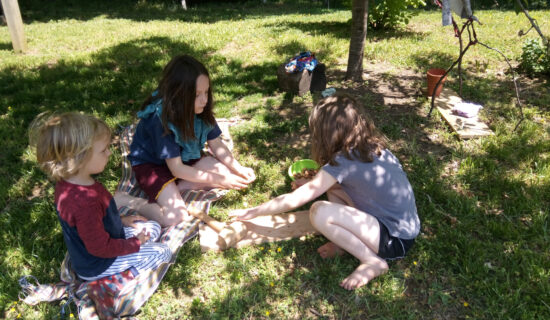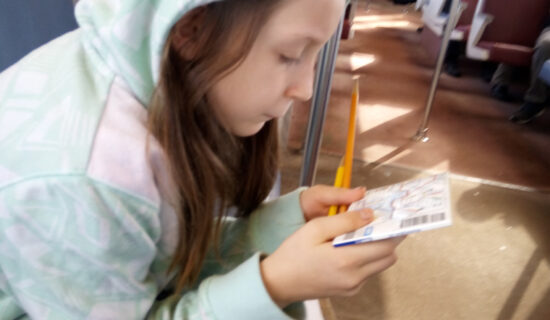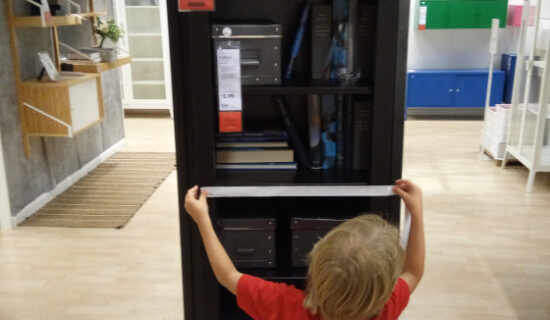Project-based learning is excellent fun and an effective way to learn almost anything. Being able to read well opens more project opportunities and makes projects easier and more fulfilling. You don’t need a course or program to teach children to read. In the right environment, they will get it on their own! Part of the ‘right environment’ is frequent read-aloud.

Everyone knows you should read to your children. Read-aloud has a positive effect on little kids’ emerging literacies, but it’s also beneficial for children of every age. Even more important than just reading, according to research, “are the times parents and children interact around print” (Strickland & Morrow 1989). Shared storybook reading is relaxed and fun, but it is not trivial.
There is a significant difference between simply reading the text to a child and interacting with the child and the text. This shared reading is a time for adults to ask young readers to participate in making meaning from the text. It is this active participation in meaning-making that is most helpful for literacy achievement (Morrow, 2007; Lynch, et al., 2008).
In this shared reading, by modeling and helping build responses, a parent or caregiver can help a child discuss and respond to text by prompting them to do so sooner than they would have on their own.
Ways to Super Power Read-Aloud:
Questioning: Asking questions of the child or the text.
“I wonder if he’s feeling sad about that.”
“Do you remember why they went to the park?”
Scaffolding: Support meaning-making by helping with reading or logic. Help just enough. We avoid giving answers they could figure out with time and prompting.
“I’m not sure…what do you think he meant?”
“Hmmm….I can think of some ways. Can you think of a way the squirrel could get up there?”
Praising: Acknowledge when the child has a thought, makes a guess, or shares a connection or idea. This isn’t about praising being right or smart, but about participating in the text by figuring it out.
“You made a guess about what would happen! That’s what good readers do! Even though you were wrong about what happened, you were right to make a guess.”
“That’s right! That IS like the place we went with grandma.”
Offering information: Sharing factual or conceptual information that helps them make sense of the story.
“This book is set during a time called The Depression, when lots of people were hungry and without work.”
“Turd is another word for poop.”
Directing discussion: As an adult, you can see the forest for the trees and guide talk to what’s worth discussing. Instead of getting caught up forever on how many candies there were in Wonka’s factory, we try to nudge the discussion to be about salient points.
“I’m thinking about what will happen when they get home and their mom sees!”
“Do you think he’s brave enough to do it? He did already climb a huge tree, but he also was scared of the big hole.”
Sharing personal reactions: One of the ways we make meaning is by taking information and running it through our personal experience filter. Good readers need to be able to have a feeling or judgement or response to what they read.
“Why do they keep talking about what the people are wearing? I’m tired of reading about what their clothes look like!”
“I don’t think it’s a good idea for them to go down the mine without an adult.”
Relating concepts to life experiences: Making connections between what we read and what we experience is part of comprehension. Model and offer connections so that children will do it, too.
“This is just like we read in the other book! They both made a disgusting snack!”
“When I was a kid, my little brother used to bother me, too. This girl has a brother who put a frog in her cup. Once, my brother chased me with a bunch of ants!”
It’s Easy: Just Talk Together While You Read
All the above is accomplished by simply talking about what you read and encouraging the child to do the same. That’s it! You don’t even need to remember this list.
If you talk together while reading, you’ll naturally ask questions and help the child answer them if needed. You’ll acknowledge when the child participates, point out elements of the story or pictures, share what you are thinking and open discussions about the text. The more the meaning-making is shared, the more the read-aloud builds literacy skills!


